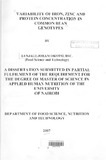| dc.description.abstract | One prerequisite for breeding micronutrient dense bean cultivars is availability of
adequate genetic variation. However the iron, ZInC and protein concentration of most
bean cultivars and landraces widely grown in Africa is not known. The objective of this
study was to screen local bean varieties for iron, zinc and protein concentration in order
to identify varieties with high mineral and protein values, acceptable grain characteristics
and to evaluate some factors influencing bioavailability of these nutrients.
Thirty-eight lines of the common bean Phaseolus vulgaris L. commonly grown in East
and Central Africa were grown for their seed in Kabete field station, University of
Nairobi. Leaf samples of the same varieties were sampled from farm plots grown by
farmers in Marani and Suneka Divisions of Kisii Central District in Nyanza Province.
Raw and cooked seed samples were analysed for their iron, ZInC and protein
concentrations in the whole bean seed and the condensed tannin concentration of the raw
seed coat. Water absorption, cooking time and sensory properties of the seed were also
determined. Attributes evaluated included colour, flavour, texture and overall
acceptabili ty
Results showed highly significant (P<O.OO1) differences in iron, zinc, protein and tannin
concentrations, water absorption capacity and cooking time of the grain. These
differences were influenced by both variety and treatment. Iron concentration In raw
beans ranged from 69.9 to 107.1 mg/kg with average of 87.1 mg/kg. The ten varieties
with the highest iron concentration were; Jesca, MLB-48-89A, Mwa Mafutala, TY -3396-
12, VCB 81013, Nain de Kyondo, AND 620, VNB 81010, Soya Fupi and G5911-2. Zinc
concentration varied from 26.9 to 43.9 mg/kg with mean of 35.9 mg/kg. The top most
promising lines for zinc concentration included AND 620, VNB 81010, Nain de Kyondo,
Nakaja, MCM 2001, Masai Red, Mexican 142, GLPX 92, RWR 10 and Ituri Matata.
Protein content varied between 20.4 % and 28.4 % with mean of 25.9 %. The following
lines had the highest protein concentration: Lib-I, AFR-708, G5911-2, Selian 97,
Mexican 142, RWR 10, VNB 81010, MCM 2001 and Lingot Blanc. With few
exceptions, nutrient concentration in cooked samples were lower than in the
corresponding uncooked ones. Retention of iron, zinc and protein averaged between 87
and 78.7 %, 87 % and 72.6 % and 89 % and 86.9 % respectively in cooked and soak cooked
bean samples. Variability of these nutrients among leaf samples was more than
in the grain. Iron values ranged from 236 to 1962 mg/kg with mean of 830 mg/kg. Zinc
concentration ranged from 17.4 to 94.7 mg/kg with average of 48.3 mg/kg. Protein
concentration varied from 23.7 % to 35.6 % with mean of 29.3 %. It was found that iron
had a statistically significant (p = 0.01) positive correlation with zinc of (r = 0.5) in seed
and (r = 0.36) in leaf across different genotypes.
Condensed tannin concentration ranged from trace to 15 %. There was significant
(p<O.OOl) variation in tannin concentration among varieties. The tannin concentration
were correlated with seed coat pigmentation. Dark coloured beans had more tannins than
light coloured beans. Red coloured beans had a mean tannin concentration of 8.5 mg/g
whole seed while white co loured beans had no detectable values.
It was also found that soaking significantly reduced bean cooking time by 33% on
average. Ten varieties with the shortest cooking times were: Awash Melka,
Mwamafutala, Kiangara, Lib-l , K132, Zebra, Ranjonomby, Kirundo, MLB 49-89A and
Simama. There was no clear relationship between water absorption and cooking time
(p=0.717). Sensory evaluation showed significant differences (p<0.001) in colour, texture
and overall acceptability among bean lines. AND 620, GLP X 92, HRS 545, Jesca and
Nain de Kyondo were identified as the most prefered. The lines identified for their good
nutritional qualities were: AND 620, G59/l-2, GLP-2, Jesca, K132, Maasai Red,
Mexican 142, MLB-49-89A, MwaMafutala, Nain DeKyondo, Roba-l , Soya fupi, TY
3396-12, VCB 81013 and VNB 81010.
The study established that several bean cultivars and landraces grown in East and Central
African region had high iron, zinc and protein values and acceptable grain characteristics.
Furthermore, results indicate that sufficient genetic variability exists to improve iron
content by 22% and zinc content by 25%. | en |

